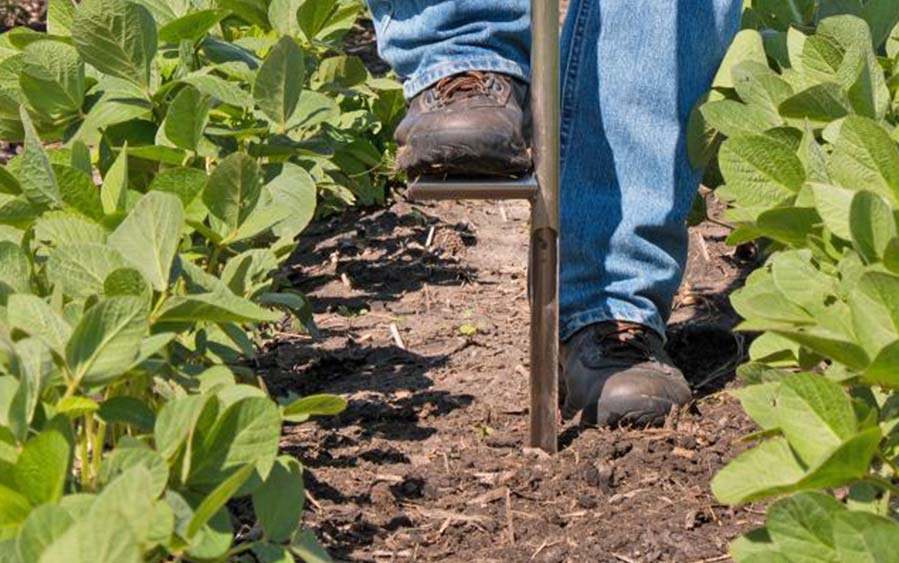Manage Pests on Your Farm: Free Soil Sample Testing for SCN

The Ohio Soybean Council (OSC) invests in agronomic research to keep yields high and pests low. Thanks to funding from the soybean checkoff and The SCN Coalition, Ohio growers can send in up to two soil samples to The Ohio State University to be tested for SCN — free of charge!
What is SCN?
Soybean cyst nematode (SCN) is the leading cause of soybean yield loss in North America. It was first identified in Ohio in 1981 and since then it has been found in 72 of the 88 counties. SCN attacks the roots of soybean plants, robbing plants of necessary nutrients and leaving wound sites for root-rotting fungi to enter. This pathogen can cause up to 22 bushel per acre of yield loss.
“One of the main reasons this nematode remains the most economically important pathogen of soybean in North America is that it can cause yield reduction between 15 to 30 percent with absolutely no visible symptoms! In addition, the use of the same source of resistance resulted in a shift in SCN virulence to adapt and parasitize soybean cultivars with SCN-resistance. In other words, nematodes are becoming resistant to the resistance,” said Horacio Lopez-Nicora, Assistant Professor in the Department of Plant Pathology at The Ohio State University.
“Soybean cyst nematode is silently gaining territory in Ohio as SCN numbers are rising. The ability to reproduce on soybean cultivars with ‘SCN-resistance’ will lead to an imminent loss in our battle to protect Ohio soybean production. Managing SCN begins with an adequate and correct soil sample.”
Why should I test?
There can be three to six generations of SCN in a single growing season and each cyst can contain 200 or more eggs. Therefore, SCN egg populations can build up very quickly on a plant in one growing season. These free soil sample tests will tell growers if SCN is present in the fields, the number of SCN per 100 cubic centimeters of soil and the severity of the SCN in your fields. Additionally, Lopez-Nicora and his team will recommend best management practices moving forward, also free of charge!
“To act, we need to know our SCN numbers. Keeping SCN population densities low and avoiding the rapid increase that could easily reach damaging levels in one growing season is easier than bringing high SCN levels back down to below damage threshold ,” states Lopez-Nicora.
Best time to test
Do you know if SCN is in your fields? If you don’t know, then the best time to test would be anytime, including now! Lopez-Nicora and his team are accepting samples year-round. Preplanting and post-harvest are good times to sample for SCN because fields are cleared, and you can start management practices to control and prevent SCN growth.
Collect and Mail
Different sampling strategies can be used to collect soil sample for SCN testing, including those used for soil fertility sampling. Lopez-Nicora’s team strongly recommends sing a 1-inch-diameter cylindrical probe to collect between 15 to 20 soil cores, 8 inches deep, for every 20 acres. Collect these soil cores in a zig-zag pattern across an area similar in soil texture and cropping history. Thoroughly mix the composite sample by gently breaking the soil cores. At this point they advise splitting the composite sample in two: one for soil fertility and one for SCN testing. Place 1 pint (approx. 2 cups) of soil in a labeled plastic bag and ship it to the lab as soon as possible.
The soil sample collected for SCN testing is alive! Handle it very carefully. To keep the nematodes alive, store the samples in a cool, dark place out of direct exposure to sunlight.
Download and complete the Soil Sample Submission Form to mail with your samples. The form contains the mailing address and any additional information. For additional questions, contact Horacio Lopez-Nicora at lopez-nicora.1@osu.edu.
To learn more about your soybean checkoff ’s investment in agronomic research and pest management, visit SoyOhio.org.

